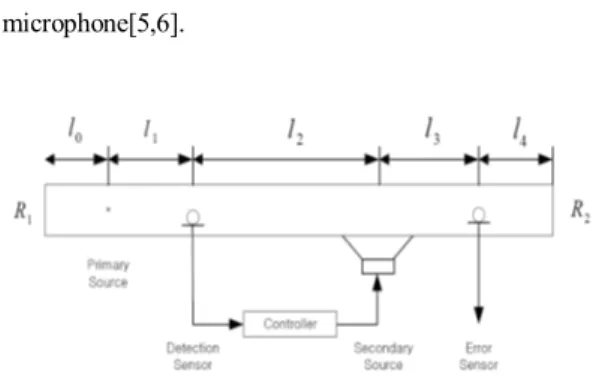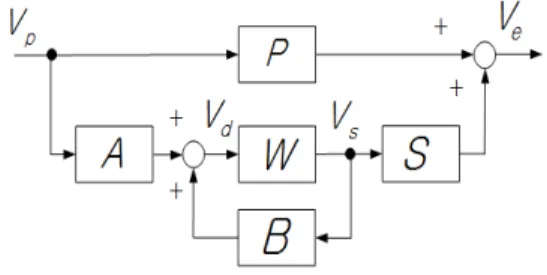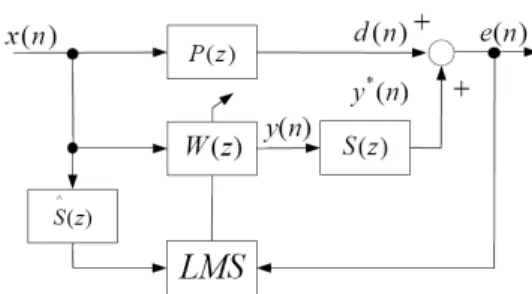Vol. 20, No. 3 pp. 570-575, 2019
1. Active Muffler
Conventional passive muffler adopts a method in
which the exhaust gas is attenuated and absorbed while passing through the shielding path in the chamber in order to reduce the exhaust noise of the internal
Design of IIR Structure Active Mufflers using Stabilized Filter Algorithms
Dong-Jun Ahn
1, Hyun-Do Nam
2*1
Department of Automotive Engineering, Ajou Motor College
2
Department of Electronics & Electrical Engineering, Dankook University
안정화 필터 알고리즘을 적용한 IIR 구조 능동 머플러의 설계
안동준1, 남현도2*
1
아주자동차대학 자동차계열,
2단국대학교 전자전기공학부
Abstract Active muffler is implemented by applying active noise control technique to reduce exhaust noise of automobile muffler. Conventional Filtered_x LMS algorithm has a problem that the degree of control filter becomes very large and convergence deteriorates when acoustic feedback is present. The recursive LMS algorithm can compensate for this problem because it can be easily diverted in the adaptive filter adaptation process. In this paper, the structure of the primary path and the secondary path transfer function is designed as the IIR filter to improve the convergence performance and the computational burden, and the stabilization filter algorithm is applied to secure stability which is a disadvantage of the IIR filter structure. The stabilization filter algorithm plays a role of pulling the pole into the unit circle to prevent the pole of the transfer function corresponding to the acoustic feedback from diverging during the adaptation process. In this way, the computational burden of the active muffler system and the convergence performance can be improved. In order to show the usefulness of the proposed system, we compared the performance of the proposed Filtered_x LMS algorithm with the performance of the proposed system for the exhaust sound of a diesel engine, which is a variable environment. Compared to conventional algorithm, proposed algorithm's computational burden is less than half, and convergence performances are more than 4 times.
요 약 능동 머플러는 자동차 머플러의 배기소음을 저감하기 위하여 능동 소음 제어 기법을 적용하여 구현된다. 기존의 보편적인 Filtered_x LMS 알고리즘은 음향 궤환이 존재할 경우 제어필터의 차수가 매우 커지고 수렴성이 악화되는 문제가 있다. 이를 보완할 수 있는 Recursive LMS 알고리즘은 적응필터의 적응과정에서 쉽게 발산할 수 있어 적용이 제한되어 왔다. 본 논문에서는 수렴 성능과 계산량 부담이 개선되도록 1차 경로와 2차 경로 전달함수의 구조를 IIR 필터로 설계하였
으며 IIR 필터 구조의 단점인 안정성 확보를 위해 안정화 필터 알고리즘을 적용하였다. 안정화 필터 알고리즘은 적응과정
중에 음향 궤환에 해당하는 전달함수의 극점이 발산하는 것을 방지하기 위하여 극점을 단위원 내부로 끌어 당기는 역할을 수행한다. 이러한 방법으로 능동 머플러 시스템의 계산량 절감과 수렴성능을 향상시킬 수 있다. 제안한 시스템의 유용성을 보이기 위하여 가변 환경인 디젤 엔진의 배기음향을 대상으로 기존의 Filtered_x LMS 알고리즘과 제안한 시스템과의 성 능을 비교하여 그 우수성을 보였으며, 계산량은 절반 이하, 수렴 특성은 4배 이상의 성능을 보였다.
Keywords : Adaptive Filter, Active Mufflers, Active Noise Control, Filtered_U LMS Algorithm, Stabilized Filter
*
Corresponding Author : Hyun-Do Nam(Dankook Univ.) Tel: +82-31-8005-3603 email: hdnam@dankook.ac.kr
Received January 15, 2019 Revised March 5, 2019
Accepted March 8, 2019 Published March 31, 2019
combustion engine. This method interferes with the smooth emission of the exhaust gas, and thus has a negative effect on the reduction of the output of the engine and the decrease of the fuel consumption.
Active mufflers[1,2] are intended to solve the above-mentioned problems by straightening the exhaust pipe to solve the disadvantages of the passive muffler.
The Filtered_x LMS (Least Mean Square) algorithm, which is mainly used for active noise control, mainly uses the FIR structure where the convergence is guaranteed and the amount of computation is proportional to the order of the control filter[3,4].
However, various studies have been made to improve the convergence characteristics due to problems such as degradation of system performance due to slow convergence characteristics.
In this paper, we propose an active muffler system designed with IIR filter structure for the control structure of the primary and secondary-paths so that the convergence performance and computational burden of the Filtered_x LMS algorithm are improved. The IIR filter structure is problematic because of divergence in the adaptation process. In this paper, a stabilization filter algorithm is applied to secure the stability of the IIR structure, and an IIR filter structure corresponding to the first and second paths is designed. In order to show the usefulness of the proposed system, Which is superior to the conventional Filtered_x LMS algorithm.
2. Mathematical Modeling of Active Muffler
Fig.1 is an active noise control system for automobile mufflers. It is assumed that the primary sound source is located at a distance of
from the engine side exhaust end of the muffler, and the microphone for detecting the sound generated by the primary sound source is a primary. It is located at
distance from the sound source, and the secondary sound source is located at distance from the
microphone[5,6].
Fig. 1. Active Noise Canceling Systems for Mufflers
The microphone used to measure the error signal is located at a distance of
from the secondary sound source and L4 from the end of the muffler, and
and
are the sound wave reflection coefficients at both ends of the muffler.
Assuming that the major electro-acoustic transfer functions of Fig.1 are linear, its can be expressed as a superimposed model as Fig. 2.
Fig. 2. Superposition Models for Active Mufflers
Fig. 1. is can be modeled into an acoustic system
with two electrical inputs (ie, used to drive voltages
and secondary sources
) and two electrical outputs
(ie, output from the error sensor
from the detection
sensor
), as shown in Fig. 2. Assuming that the
principle of superposition is established for each
electric transfer function and the input voltage of the
other side is set to 0 similarly to the 4 terminal
network, the ratio of each input and output can be
defined as Eq. (1).
≅
≅
≅
≅
(1)
In Eq. (1), transfer function B represents the acoustic feedback path. Since the transfer function of the controller is the principle of superposition, assuming all the components of the system (acoustic, electrical and electro-acoustic) to be linear, the two output voltages will have the form as Eq. (2).
(2)
Assuming that the transfer function of the controller W is linear in Fig. 2., block diagram of superposition models can be represented by Fig. 3.
Fig. 3. Block Diagram of Superposition Models
In order to convert the transfer functions P, A, B and S to a discrete system, For example, Primary transfer function is treat the term for the net delay time as integer and replace the delay time with the backward difference operator
as Eq. (2). In Eq.
(2), the delay time coefficients are affected not only physical distance but also speed of sound c and sampling frequency .
where (2)
3. Design of Adaptive Filter
The adaptive filter algorithm shown in Fig. 4. which has a main purpose in achieving the control objective by estimating unknown system coefficients.
Fig. 4. Adaptive Filter Algorithms
(3)
(4)
where is LMS(Least Mean Square) control vector and is input signal vector, is arbitrary constant, L is Filter Tap
In Eq. (3), and are primary source and primary path output signal, and and are controller output, and control error signals of the system, respectively. In Eq. (4), the proper selection of the convergence factor to determine the control filter vector determines the performance of the system.
There have been many studies to determine the optimal
convergence factor, And the NLMS (Normalize LMS)
algorithm that takes the norm of the input signal vector
and reflects it on the convergence coefficient. Since the
NLMS algorithm has a variable constellation
coefficient, its proper choice depends on the
performance of the system.
3.1 Filtered_x LMS algorithms
In Fig. 4., the control output is physically generated through the secondary sound source from the control speaker, and is canceled with the primary sound source, which is referred to as a secondary path.
Since the primary and secondary path transfer function are unknown or time-varying in many cases, it is necessary to obtain the optimal value by real-time estimation using the adaptive filter. Considering the existence of the secondary path, appropriate solution of control filter is called Filtered_x LMS algorithm (in Fig. 3-2,
is the secondary path output,
∧
is pre-estimated secondary transfer function)[7].
Fig. 5. Filtered_x LMS Algorithms
3.2 Proposed algorithms
In the case of the acoustic feedback as shown in Fig. 5., since the order of the control filter should be very large because of the influence of the pole location of transfer function B in Eq. (2), Filtered_x LMS algorithm has a disadvantage in that the order of control filter is very increased and the convergence speed is slowed down[4].
Apaptive IIR filters structure which to solve above problems, its called recursive LMS (RLMS) algorithm or Filtered_U LMS algorithm.(Fig. 6.)
In Eq. (3) shows the Filtered_U LMS algorithms.
′ (5) where
′ ≡
∧
Eq. (5) can be partitioned into two vector equations for adaptive filters
and
as follows.
′
′
(6) where
′
∧
′
∧
Even though IIR structure is more efficient than FIR structure, RLMS algorithms are may have stability problems especially when the adaptive algorithm for adaptive filters is not yet converged.
In this paper, we propose an active muffler system designed with IIR filter structure for the control structure of the primary and secondary-paths so that the convergence performance and computational burden of the Filtered_x LMS algorithm are improved[8].
Eq. (6) shows stabilized procedure that before the RLMS algorithms converge, poles of the IIR filter are pulled to the center of the unit circle, and the poles are returned to their original positions after the filter converges. Acoustic feedback transfer function
in Fig 6. is modified as
(7)
where
≤ ≤
Stabilized coefficient is determined by adaptation
speed.
4. Computer Simulation
In order to show the usefulness of the proposed IIR type active muffler system, computer simulation was performed. Table 1, 2 shows the physical specifications of the muffler and common simulation parameters[9].
Table 1. Muffler Parameters
Variable Symbol Value
Reflection Coefficient
0.2, 0.1
Physical Length
0.3[m]
0.5[m]
1.9[m]
0.5[m]
0.3[m]
Table 2. Simulation Parameters
Variable Value
Sound Speed 340[m/s]
Sampling Freq. 2[kHz]
Execution Step 3,000[1.5Sec]
Noise Source Diesel Muffler Noise Secondary Path
Order
Filtered_x 96
IIR Stabilized 32+8
Control Filter Order
Filtered_x 192
IIR Stabilized 96
Convergence Coefficient
Filtered_x 0.00005
IIR Stabilized 0.003 Stabilized
Coefficient



![Fig. 8. shows the time evolution of exhaust noise when the diesel engine was varied from 1000 to 3000[RPM]](https://thumb-ap.123doks.com/thumbv2/123dokinfo/5121059.577828/5.799.88.385.435.627/fig-shows-evolution-exhaust-noise-diesel-engine-varied.webp)